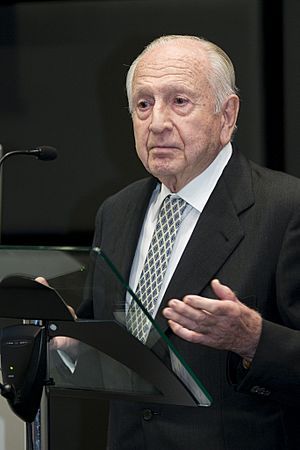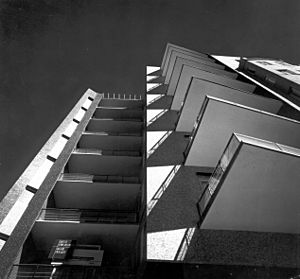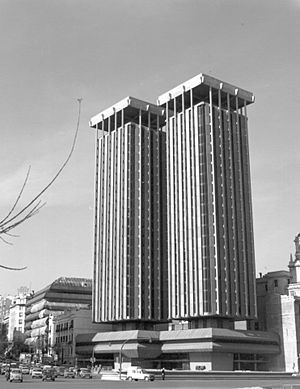Antonio Lamela facts for kids
Quick facts for kids
Antonio Lamela
|
|
|---|---|

Antonio Lamela in 2010
|
|
| Born | December 1, 1926 Madrid, Spain
|
| Died | April 1, 2017 (aged 90) Madrid, Spain
|
| Nationality | Spanish |
| Alma mater | Technical University of Madrid |
| Occupation | Architect |
| Practice | Estudio Lamela |
| Buildings | Santiago Bernabéu Stadium Adolfo Suárez Madrid–Barajas Airport Torres de Colón |
Antonio Lamela Martínez (born December 1, 1926 – died April 1, 2017) was a famous Spanish architect. He was known for his fresh ideas and modern designs.
Contents
Antonio Lamela's Life and Work
Antonio Lamela was born in Madrid, Spain. He finished his architecture studies in 1954 and earned his doctorate in 1959. From the very start, he was an architect who looked to the future. He loved to explore new ideas and traveled a lot, which helped him get many new perspectives.
- In 1954, he started his own architecture company called Estudio Lamela. He worked there for his entire career.
- Between 1956 and 1958, he built a special apartment building in Madrid. It was the first one to have air conditioning, individual trash chutes, and even walls that could move! These ideas were very new back then. He went on to design many other modern buildings and even whole neighborhoods for thousands of people. In 1960, he designed the first supermarket in Spain.
- Antonio Lamela was also a leader in designing buildings for tourists in Spain. He created the first modern motels and hotels. He played a big part in the tourism boom of the 1960s, designing new resorts on the coasts of Majorca and the Costa del Sol.
- He was the first architect in Spain to use the idea of an "Office landscape". This means an office space without many closed rooms, where everyone works together in an open area. He used this idea for his own company's office in Madrid. This office had new features like special ceilings for lighting and sound, soft carpeted floors, and unique walls to control sunlight.
- Lamela also brought the idea of "suspended architecture" to Spain with his Torres Colón project in Madrid. Imagine a building where the floors hang down from a strong structure at the top, instead of being built up from the ground! The Colón Towers were a world record holder for having 21 suspended floors when they were built. This made them very advanced for their time.
- In 1973, he created a company called Gestión y Control. This company was one of the first to manage all parts of a building project, from start to finish. He wanted architects to be in charge of every step. He also started other companies, like ADI (Architecture, Decoration and Engineering), which combined different design skills.
New Ideas in Building Materials
In 1965, Antonio Lamela introduced ready-mixed concrete to Spain. This meant that concrete was mixed in trucks and delivered to building sites, which was a big change from mixing it on site. These were the first concrete-mixer trucks seen on Spanish roads!
In 1968, he started another company called Shockbeton. This company made large, pre-made concrete parts for building facades (the outside of buildings). This was also a first in Spain and helped create beautiful and strong buildings. He also started CTC, a company that supplied bricks in special packages.
Famous Projects: Santiago Bernabéu Stadium and Barajas Airport
Antonio Lamela designed two very important buildings in Madrid. The first was the renovation and expansion of the Santiago Bernabéu Stadium in 1988. This is the home stadium for the famous Real Madrid Football Club.
The second big project was the award-winning Terminal 4 of the Barajas Airport (now called Adolfo Suárez Madrid-Barajas Airport). He worked on this with another famous architect, Richard Rogers.
Global Connections and Writings
In 1976, Lamela helped start the Spanish branch of the Club of Rome. This is an international group that works to make the world better through education and fair development.
Antonio Lamela also wrote many books and articles. He wrote about how land should be used, water policies, protecting the environment, and even about the Spanish language.
His architecture work includes more than 1,500 projects. These projects show a lot about Spain's history during his time.
He also invented new ideas called "Geoísmo" and "Cosmoísmo" in a book from 1975. These ideas were about planning cities and human life on a global scale. He talked about "naturalism," which was his way of describing what we now call Sustainable architecture – designing buildings that are good for the environment.
Key Projects
- 1956 - Swissair Offices (Madrid)
- 1956 - Homes at 33 O'Donnell Street (Madrid)
- 1958 - Housing in the Paseo de la Castellana (Madrid)
- 1959 - El Hidalgo Motel
- 1962 - Roca Marina Group, La Caleta Building and Apartotel Magalluf (Palma de Mallorca)
- 1963 - Meliá Princesa Hotel (Madrid)
- 1963 - Playamar, La Nogalera and Meliá hotel complex in Torremolinos (Málaga)
- 1964 - Offices at 34 O'Donnell Street (Madrid)
- 1964-1970 - San Ignacio de Loyola neighborhood (Madrid)
- 1965 - Galaxia Group (Madrid)
- 1967 - Torres Colón (Madrid)
- 1972 - The Pyramid Building (Madrid)
- 1973 - Bank building at 27 Genova Street (Madrid)
- 1984 - Laroc Condominium - Florida (USA)
- 1988 - Enlargement and remodeling of the Santiago Bernabéu Stadium (Madrid)
- 1997 - New Terminal T-4 of the Madrid-Barajas Airport – worked with Initec, Richard Rogers and TPS.
Exhibitions of His Work
- 2013. Madrid. Roca Madrid Gallery: "Estudio Lamela: 60 years of Architecture in Madrid."
- 2010. Madrid. COAM Foundation: "Estudio Lamela 1954-2010." This showed his most important works.
- 2006. New York (USA). On Site: New Spanish Architecture. Featured the T4 Madrid-Barajas Airport.
- 2005. Madrid. Ministry of Housing: "Lamela 1954-2005." This big exhibition celebrated his 50 years as an architect.
Awards and Honors
- 1998. Member of the Real Academy of Doctors of Spain.
- 2005. Grand Cross of the Order of Civil Merit.
- 2005. Gold Medal of Merit in Work.
- 2006. King Jaime I Prize for "Urbanism, Landscape and Sustainability."
- 2006. Member of the High Advisory Council on Research, Development and Innovation.
- 2006. Chairman of the Academic Council of the Camilo José Cela University.
- 2006. Stirling Prize for the Madrid-Barajas Airport.
- 2006. Urbanism Prize from the City Hall of Madrid.
- 2007. Professor Doctor Honoris Causa from the University of Camilo José Cela.
- 2010. Award for European Excellence from the Madrid Community.
- 2010. Honorary Member of the Official College of Architects of Madrid.
Groups He Belonged To
- Co-founder of the Spanish Chapter of the Club of Rome – Madrid (1976).
- Honorary Member of the Círculo de Bellas Artes – Madrid (1979).
- Member of "Hispania Nostra," a Spanish group for protecting the environment and cultural heritage.
- Vice President and founding partner of the Spanish Energy Club (1985).
- Advisor for Professional Cooperation at the Antonio Camuñas Foundation – Madrid (1990).
- Member of the Academic Council of the "Antonio Camuñas" Foundation.
- Member of the Spanish Institute of Energy.
- Founding President of the Association for the Defense of Reservoirs of Entrepeñas, Buendía and surrounding areas (ADEB) (1992).
- Member of the Governing Board of the Society for International Studies of the Centre for Scientific Research (CSIC) – Madrid (1993).
- Founding Member of the Water Forum – Madrid (1996).
- Founding Member and Director of the Spanish Club of the Environment (CEMA).
- Member of the Spanish Committee of the World Energy Council.
See Also
 In Spanish: Antonio Lamela para niños
In Spanish: Antonio Lamela para niños







